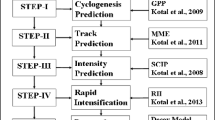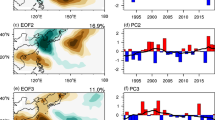Abstract
In this study, an attempt has been made to develop a simple multiple regression model to forecast the total number of depressions and cyclones (TNDC) over Bay of Bengal during summer monsoon (June–September) season using the data for the period, 1995–2016. Four potential predictors (zonal wind speed at 850 hPa in May and April SST in the North Australia–Indonesia region, 05°S–15°S; 120°E–160°E; March NINO 3.4 SST and geopotential height at 200 hPa in the region, 0°N–10°N; 80°E–100°E) have been identified to forecast TNDC. A remarkably high multiple correlation coefficient of 0.92 has been observed with the TNDC which explains 85% variability. The methodology has been tested for the recent 5 years (2012–2016) and found a good agreement between the observed and forecast values of TNDC except in 2015 in which the observed and predicted TNDC were 2 and 0, respectively. It is interesting to see high and significant correlations between the above predictors and the genesis potential parameter (GPP) during summer monsoon season. This GPP depends on the relative vorticity at 850 hPa, mid troposphere relative humidity, thermal instability between 850 and 500 hPa, and vertical wind shear between 200 and 850 hPa. It is inferred that the above predictors are influencing the environmental conditions over Bay of Bengal which, in turn, influencing the genesis of cyclones during summer monsoon season. The impact of ENSO (El-Nino-Southern Oscillation) and La-Nina in TNDC is examined and found that the vertical wind shear and relative vorticity are high and the GPP was almost double in ENSO compared with that in La-Nina which favoured high (low) TNDC under ENSO (La-Nina).



Similar content being viewed by others
References
Balachandran S, Geetha B (2012) Statistical prediction of seasonal cyclone activity over North Indian Ocean. Mausam 63:17–28
Chan JCL, Shi JE, Lam CM (1998) Seasonal forecasting of tropical cyclone activity over western north pacific and the south China sea. Weather Forecast 13:997–1004
Chan JCL, Shi JE, Liu KS (2001) Improvements in the seasonal forecasting of tropical cyclone activity over the western north Pacific. Weather Forecast 16:491–498
Dhar ON, Rakhecha PR, Mandal BN (1981) Influence of tropical disturbances on monthly rainfall over India. Mon Weather Rev 109:188–190
Kalnay et al (1996) NCEP/NCAR 40 year Reanalysis project. Bull Am Met Soc 77:437–471
Kikuchi K, Wang B (2010) Formation of tropical cyclones in the northern Indian Ocean associated with two types of tropical intra seasonal oscillation modes. J Meteor Soc Jpn 88:475–496
Klotzbach PJ, Gray WM (2004) Updated 6–11 month prediction of Atlantic basin seasonal hurricane activity. Weather Forecast 19:917–934
Kotal SD, Kundu PK, Roy Bhowmik SK (2009) Analysis of cyclogenesis parameter for developing and non developing low pressure systems over the India Sea. Nat Hazards 50:389–402
Krishnamohan KS, Mohan kumar K, Joseph PV (2012) The influence of Madden–Julian oscillation in the genesis of north Indian Ocean cyclones. Theor Appl Climtol 109:271–282
Mohapatra M, Adhikary S (2010) Seasonal prediction of cyclonic disturbances over Bay of Bengal during summer monsoon season: identification of potential predictors. Mausam 61:469–486
Mooley DA (1973) Some aspects of Indian monsoon depressions and the associated rainfall. Mon Weather Rev 109:188–190
Nicholls N (1984) The Southern oscillation, sea surface temperature and inter annual fluctuations in Australian seasonal cyclone activity. Climatology 4:661–670
Nicholls N (1992) Recent performance of a method for forecasting Australian seasonal cyclone activity. Aust Met Mag 40:105–110
Nicholls N (1995) All-India summer monsoon rainfall and sea surface temperatures around north Australia Indonesia. J Climate 8:1463–1467
Rajendra kumar J, Dash SK (2001) Inter decadal variations of characteristics and their epochal relationships with rainfall and other tropical features. Int J Climatol 21:759–771
Revell CG, Goulter SW (1986) Lagged relationships between the Southern oscillation and numbers of tropical cyclones in the southern pacific region. Mon Weather Rev 114:2669–2670
Sadhuram Y (2016) Can we predict the cyclone activity over Bay of Bengal during October–December? Mausam 67(4):952–954
Sadhuram Y, Maneesha K (2016) Relationship between summer monsoon rainfall and cyclogenesis over Bay of Bengal during post-monsoon (October–December) season. J Earth Syst Sci 125(7):1473–1479
Singh OP (2008) Indian ocean dipole mode and tropical cyclone frequency. Curr Sci 94:29–31
Singh OP, Khan TMA, Rahman MS (2001) Probable reasons for enhanced cyclogenesis in the Bay of Bengal during July–August of ENSO years. Global Planet Chang 29:135–147
Singh OP, Khan TMA, Rahman MS (2002) Impact of southern oscillation on the frequency of monsoon depressions in the Bay of Bengal. Nat Hazards 25:101–115
Smith TM, Reynolds RW, Peterson TC, Lawrimore J (2008) Improvements to NOAA’s Historical merged Land-Ocean surface analysis (1880–2006). J Climate 21:2283–2296
Yanase W, Masaki S, Hiroshi T, Fujinami H (2012) Seasonal and intra seasonal modulation of tropical cyclogenesis environment over the Bay of Bengal during extended summer monsoon. J Climate 25:2914–2930
Acknowledgements
The authors thank Dr. S. W. A. Naqvi, Director, CSIR-NIO, Goa and Dr. V. S. N. Murty, Scientist-in-Charge, CSIR-NIO Regional centre, Visakhapatnam, for providing the facilities. They thank all the project teams of NOAA, Bureau of Meteorology, Australia, and IMD, New Delhi for making the data sets available on the Websites. Senior author (YS) would like to thank CSIR, New Delhi, for providing funds under Emeritus Scientist scheme. One of the authors K. Maneesha duly acknowledges financial support received from DST SERB under young scientist scheme. Thanks to both the reviewers for their valuable suggestions/comments which helped to improve the original version of the manuscript. This is NIO contribution number 5989.
Author information
Authors and Affiliations
Corresponding author
Additional information
Responsible Editor: J. T. Fasullo.
Rights and permissions
About this article
Cite this article
Sadhuram, Y., Maneesha, K. & Suneeta, P. A simple method to forecast the frequency of depressions and cyclones over Bay of Bengal during summer monsoon season. Meteorol Atmos Phys 130, 169–174 (2018). https://doi.org/10.1007/s00703-017-0511-3
Received:
Accepted:
Published:
Issue Date:
DOI: https://doi.org/10.1007/s00703-017-0511-3




